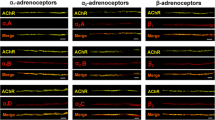Summary
As well as causing the release of acetylcholine and the disappearance of synaptic vesicles from somatic nerve endingsLatrodectus venom also causes the release of noradrenaline and the disappearance of small vesicles from adrenergic nerve endings. The large granular vesicles of the adrenergic endings are less sensitive to the action of the venom.
Similar content being viewed by others
References
Chen, I. L. andLee, C. Y. (1970) Ultrastructural changes in motor nerve terminals caused by β-bungarotoxin.Virchows Archiv Abteilung B. Zell Pathologie 6, 318–25.
Clark, A. W., Hurlbut, W. P. andMauro, A. (1972) Changes in the fine structure of the neuromuscular junction of the frog caused by black widow spider venom.Journal of Cell Biology 52, 1–14.
Clark, A. W., Mauro, A., Longenecker, H. E. Jr. andHurlbut, W. P. (1970) Effects of Black widow spider venom on the frog neuromuscular junction. Effects on the fine structure of the frog neuromuscular junction.Nature (London) 225, 703–5.
Frontali, N. (1972) Catecholamine-depleting effect of black widow spider venom on iris nerve fibres.Brain Research 37, 146–8.
Geffen, L. S. andLivett, B. G. (1971) Synaptic vesicles in sympathetic neurons.Physiological Reviews 51, 98–157.
Hamilton, R. C. (1972) Ultrastructural studies of the action of Australian spider venoms. In30th Annual Proceedings of the Electron-Microscopy Society of America (edited byArceneaux, C. J.) pp. 40–1. Baton Rouge: Claitor's Publishing Division.
Malmfors, T. andSachs, C. (1968) Degeneration of adrenergic nerves produced by 6-hydroxydopamine.European Journal of Pharmacology 3, 89–92.
Okamoto, N., Longenecker, H. E. Jr., Riker, W. F. andSong, S. K. (1971) Destruction of mammalian motor nerve terminals by black widow spider venom.Science 172, 733–6.
Tranzer, J. P. andThoenen, H. (1968) An electron microscopic study of selective, acute degeneration of sympathetic nerve terminals after administration of 6-hydroxydopamine.Experientia 24, 155–6.
Van Orden, L. S. III., Bloom, F. E., Barrnett, R. J. andGiarman, N. J. (1966) Histochemical and functional relationships of catecholamines in adrenergic nerve endings. I. Participation of granular vesicles.Journal of Pharmacology and Experimental Therapeutics 154, 185–99.
Author information
Authors and Affiliations
Rights and permissions
About this article
Cite this article
Hamilton, R.C., Robinson, P.M. Disappearance of small vesicles from adrenergic nerve endings in the rat vas deferens caused by red back spider venom. J Neurocytol 2, 465–469 (1973). https://doi.org/10.1007/BF01103802
Received:
Revised:
Accepted:
Issue Date:
DOI: https://doi.org/10.1007/BF01103802




